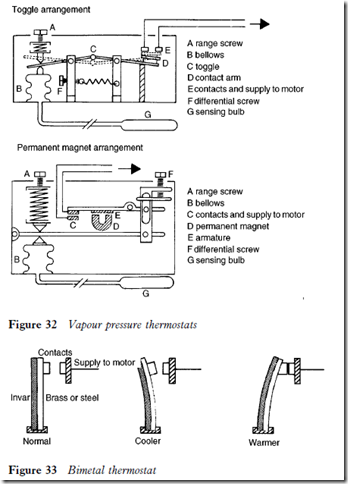Motor cycling controls: thermostats
Two types of thermostat are commonly used to control the temperature of a refrigerated space or product by stopping and starting the compressor.
The most popular is the vapour pressure type. This consists of a small bulb or sensing element containing a very volatile liquid charge. The liquid has the ability to vaporize at low temperatures. When the bulb is subjected to a rise in temperature, the pressure generated by the vaporizing liquid will increase.
A capillary connects the bulb to a bellows or diaphragm. The vapour pres- sure causes the bellows to expand or the diaphragm to flex and operate the switch mechanism, closing the contacts to start the compressor motor. As the sensing element or bulb cools, the pressure in the bellows or diaphragm will decrease. The bellows will contract or the diaphragm will return to its normal position, thus opening the electrical contacts to stop the compressor.
Switch mechanisms have some form of toggle action or a permanent magnet device to ensure rapid and positive make or break of the switch contacts. This prevents arcing, which occurs when electrical current jumps across the minute gap between the contacts. Figure 32 shows toggle and permanent magnet switch arrangements.
The permanent magnet snap action type has a switch contact arm made of a magnetic material (iron or steel), and the magnet attracts the arm towards it. The pressure from the sensing element acts against the magnetic attraction to close the contacts according to the temperature of the element or bulb. As the arm moves closer to the magnet, the magnetic effect increases to cause the snap action.
When the sensing element cools and the switch bellows contract, some force is necessary to open the contacts. However, the magnetic force decreases as soon as the contacts break to allow rapid opening.
The compound bar type of thermostat, more generally called a bimetal element, comprises two dissimilar metals, usually Invar and brass or Invar and steel. Invar is an alloy which has a very low coefficient of expansion, whilst brass and steel have a relatively high coefficient of expansion. When an increase or decrease of temperature is sensed by the bimetal element the length of the Invar will cause the bimetal to warp. This warping action is utilized to open and close the switch contact (Figure 33).
Thermostats have range and differential adjustments which can be altered in the same manner as previously described for pressure controls. Electrical terminal arrangements will obviously differ by manufacturer, and reference should be made to the literature supplied with the controls.
The range on thermostats used on domestic appliances is altered by turning the cold control. Some of these are marked with a warmer or cooler setting. Others are numerical: the higher the number, the lower the temperature. Adjustment of the differential should not be attempted.
Some domestic appliance thermostats have a two-way switching feature in their design. When cooling is no longer required and the cut-out point of the witch is reached, the contacts to the compressor are opened and the contacts to a defrost heater are closed. This achieves automatic defrosting after every on cycle, to keep a minimal frost build-up on the evaporator at all times for more efficient operation.
System faults
Sealed systems such as domestic refrigerators and freezers need to be treated differently, since there may not be provision for fitting gauges unless line tap valves are used.
If the temperature control is by thermostat only and there is no low pressure safety control, continuous running of the unit will result if the system:
1 Is short of refrigerant or has a restriction in the liquid line.
2 Is operating in a high ambient temperature or with restricted air flow over the condenser.
3 Has a faulty fixture door seal, imposing a high evaporator load.
4 Has excessive frost build-up on the evaporator.
5 Is operating with a defrost heater in circuit (has a defective timer), giving a high evaporator load.
Domestic system repairs will be dealt with in detail in Chapter 8.
Noise
The sources of noise are numerous, and in some cases are entirely dependent upon the location and the type of building structure.
Common sources of noise are as follows:
1 Line rattles, that is pipework or control tubing vibrating against an evap- orator or condenser shroud or framework.
2 Items of stored products (metal containers) or storage shelves vibrating.
3 Evaporator or condenser fan mountings loose.
4 Condensing unit base mountings or mounting frame loose; inadequate noise suppression from mounting fabric used (Tico pads, for example).
5 Perished rubber mounting grommets, which are especially prone to deterioration if contaminated with oil and refrigerant.
6 Gas pulsations against a rigid pipework design, creating a noise source during operation or when the compressor starts and stops.
7 Incorrect belt tension or belt and drive pulley alignment with open-type condensing units.
A better assessment of noise problems can be made after a study of the pipework design and installation recommendations (Chapter 10).
